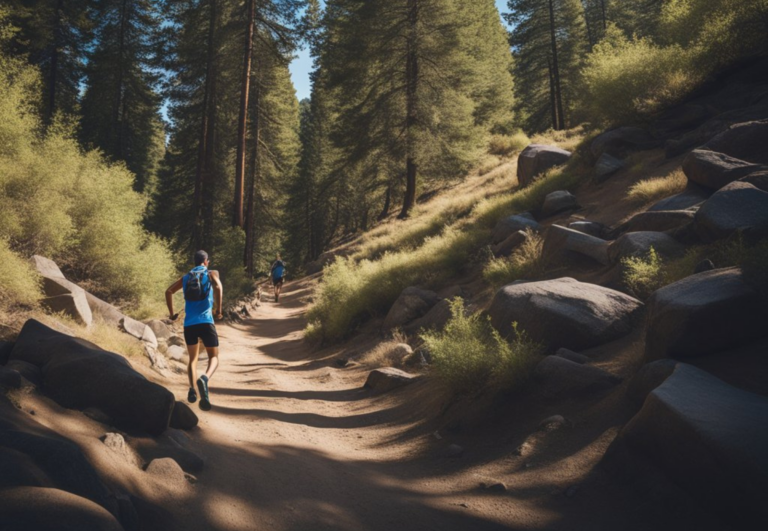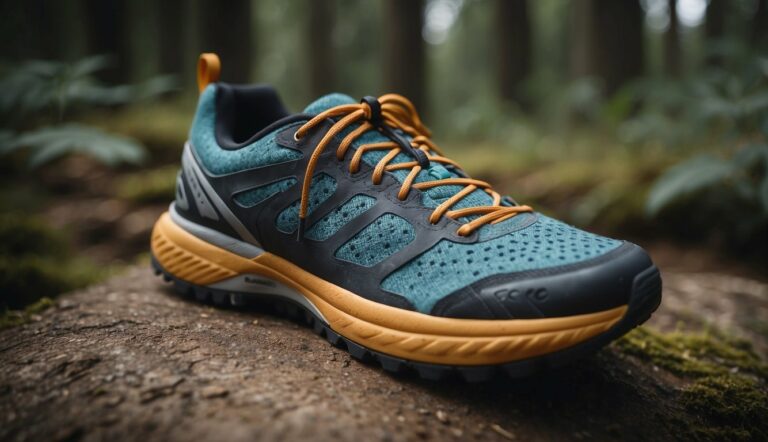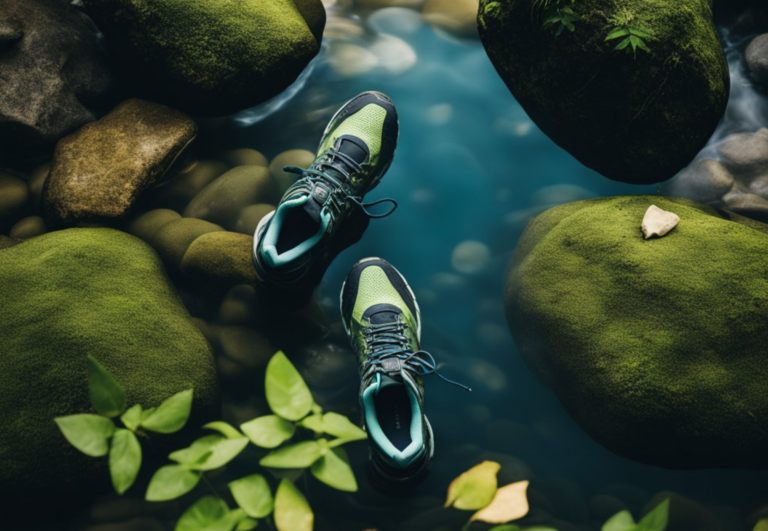How to Layer Clothing for Trail Runs: Mastering Temperature and Conditions
When preparing for a trail run, layering your clothing is essential for comfort and safety. As a UESCA certified running coach with hands-on experience, I understand that body temperature regulation is key. To maintain optimal performance and avoid overheating or getting too cold, you should start with a moisture-wicking base layer that keeps your skin dry by drawing sweat away. This is crucial in all weather conditions, as damp skin can rapidly lead to discomfort or even hypothermia in colder climates.
The temperature and weather conditions will determine the next layers. In moderate conditions, a light insulated mid-layer can provide warmth without the bulk. For colder environments, you might need a heavier mid-layer to retain body heat. The outer layer should act as a shield against wind and rain while still allowing for ventilation. This system ensures you can adapt to changing conditions, removing or adding layers as necessary during your trail run.
As you set out on the trails, remember that personal comfort levels and weather patterns vary greatly. Some runners may need extra insulation even at milder temperatures, while others might prefer fewer layers. It’s always safer to pack an additional layer than to be caught unprepared. Keep your layers breathable, consider the specific demands of trail running, and adjust as you go to enjoy a safe and comfortable run, no matter where the trail takes you.
The Importance of a the Layering System for Trail Runners

Layering for trail runs allows for flexibility and protection in various temperatures and conditions. The right combination of layers works seamlessly to manage moisture, insulate the body, and shield from weather elements.
Base Layers
Purpose: Moisture management
- Materials: Merino wool or synthetic polyester
- Characteristics: Moisture-wicking, breathable, lightweight
- Examples:
- Merino wool base layer: Excellent for odor control and thermoregulation
- Synthetic base layer: Quick-drying and durable
As a UESCA certified running coach, I recommend runners choose a base layer that keeps the skin dry by wicking moisture away. This first layer should fit snugly to maximize its moisture-wicking capabilities without obstructing movement.
Mid-Layers
Purpose: Insulation
- Materials: Fleece, down, or synthetic insulation
- Characteristics: Trap and retain heat, breathable
- Examples:
- Fleece mid-layer: Provides warmth and continues to insulate even when damp
- Insulated jacket: Down or synthetic fill offers a higher warmth-to-weight ratio
Mid-layers are all about maintaining body temperature. The key is to have a layer that can be easily added or removed as conditions change. Fleece is versatile for varying intensities of activity, while insulated jackets may be preferable for colder conditions.
Outer Layers
Purpose: Protection from external elements
- Materials: Typically fabrics with water-repellent and wind-resistant properties
- Characteristics: Durable, breathable, able to repel rain and block wind
- Examples:
- Lightweight, breathable shell: Ideal for protection without overheating
The outer layer is your shield against wind, rain, and snow. For a trail run, a lightweight, breathable shell is critical, as it provides protection without contributing to overheating. It should also offer enough room for the layers beneath.
How To Layer for Conditions and Temperatures
I know how crucial it is to dress appropriately for varying weather conditions during trail runs. Proper clothing can manage body temperature effectively, prevent discomfort from sweat, and protect against the elements like sun, wind, and precipitation.
Hot and Sunny Conditions
In hot and sunny conditions, the aim is to facilitate sweat evaporation and provide sun protection without overheating. For this, a light-colored, moisture-wicking base layer is essential to keep the skin dry.
I recommend materials such as polyester or bamboo that offer UPF protection to guard against harmful UV rays. A running cap and UV-blocking sunglasses are non-negotiable for direct sun exposure.
- Top: Light-colored, moisture-wicking T-shirt
- Bottom: Moisture-wicking, breathable shorts
- Accessories: UPF-rated cap, sunglasses
Cold Weather Challenges
When the mercury drops, layering is key to maintain warmth without sweating excessively. Start with a moisture-wicking base layer next to your skin.
Add a breathable thermal mid-layer for insulation, and if temperatures are below 10 degrees Fahrenheit, consider an additional fleece. A weather-resistant shell with DWR (Durable Water Repellent) coating and wind-blocking capabilities is crucial for layers. Avoid cotton, as it retains moisture and diminishes insulation when wet.
- Base Layer: Moisture-wicking synthetic or wool top and bottom
- Mid-Layer: Breathable fleece or insulated jacket
- Outer Layer: Wind and water-resistant jacket with DWR coating
Rain, Snow, and Wet Conditions
Wet conditions demand an outer layer that is waterproof and breathable to keep you dry from rain or snow. Ensure your jacket and pants have sealed seams to prevent water seepage.
Gaiters can also be useful to keep snow and rain from entering your shoes. Despite waterproof gear, maintain a balance to prevent overheating and excess sweating, as retained moisture can lead to rapid cooling once you stop running.
- Outer Layer: Waterproof, breathable jacket and pants with taped or sealed seams
- Footwear Adapter: Gaiters for additional protection against snow and rain
Selecting Materials and Fabrics
When preparing for a trail run, choosing the right fabrics can significantly affect your comfort and performance. Selecting materials that accommodate weather conditions and your body’s needs will enhance your running experience.
Natural vs. Synthetic
Natural Fabrics:
- Wool: Ideal for insulation, while being breathable and moisture-wicking. Merino wool, in particular, offers a softer texture that is less irritating to the skin.
- Cotton: Generally avoided for performance wear as it absorbs moisture, which can lead to discomfort and chafing.
Synthetic Fabrics:
- Nylon: Highly durable and resistant to abrasion. Its quick-drying properties make it suitable for outer layers.
- Polypropylene: A moisture-wicking base layer fabric that keeps the skin dry. It’s also lightweight and retains warmth when wet.
- Gore-Tex: A breathable, waterproof, and windproof material commonly used in jackets and outer layers to protect against harsh conditions.
| Fabric Type | Properties | Best Layer | Conditions Suitable |
|---|---|---|---|
| Wool | Breathable, Moisture-wicking | Base Layer | Cold, Moderate |
| Cotton | Moisture-absorbent | Avoid in Technical Gear | Dry, Casual |
| Nylon | Durable, Quick-drying | Outer Layer | Wet, Abrasive |
| Polypropylene | Warmth, Moisture-wicking | Base Layer | Cold, Wet |
| Gore-Tex | Waterproof, Windproof, Breathable | Outer Layer | Wet, Windy, Cold |
Technical Fabrics
Key Characteristics:
- Water-resistant: Minimally protects against moisture but is not fully waterproof.
- Waterproof: No water penetration, often with the use of membranes like Gore-Tex.
- Windproof: Blocks wind to preserve body heat.
- Breathable: Allows sweat to evaporate and prevents overheating.
Types of Technical Fabrics:
- Soft Shell: Combines warmth and breathability, generally water-resistant and suitable for mild, variable conditions.
- Hardshell: The ultimate protective layer against severe weather; usually waterproof and windproof.
In my experience, the use of technical fabrics greatly impacts performance, especially when conditions are demanding. It’s essential to have a layer that can efficiently transport moisture away from the skin to keep you dry and to employ an outer layer that can shield you from rain, snow, and wind. Always consider the specific conditions of your trail run to determine the best combination of materials and fabrics.
Accessories and Additional Gear

In trail running, the right accessories enhance comfort and safety. It’s not just about what you wear; it’s also about what you bring along. From headwear to hand protection, each item plays a crucial role in your running experience.
Headwear and Hand Protection
I recommend wearing a hat or a beanie to shield you from the sun’s rays or to provide warmth in colder temperatures. A headband or neck gaiter can be useful for additional warmth or to keep sweat out of your eyes. During colder weather, gloves or mittens are essential to protect your hands from the cold. For sunnier days, don’t forget to bring sunglasses to protect your eyes against UV rays.
- Headcoverings: Choose a beanie for cold days or a breathable hat for sunny ones.
- Hand Protection: Mittens for coldest days; gloves for milder, cool weather.
- Sun Protection: Always have sunglasses to shield against harmful UV rays, regardless of the temperature.
Footwear Considerations
The importance of socks cannot be overstated. I suggest wool socks for their ability to wick moisture away and prevent blisters. If conditions are wet or cold, waterproof socks may be beneficial. Alongside the socks, your shoes are critical—you want a pair that provides good traction, comfort, and the right level of warmth for the temperature.
- Socks: Wool is best for moisture management and warmth. Consider thickness based on temperature.
- Shoes: Tread for traction, breathable material for comfort, and consider water resistance for wet conditions.
Remember, layering light jackets or vests over a moisture-wicking t-shirt can provide adequate warmth without overheating. Lastly, even if you wear shorts, it’s wise to pack long underwear in case the weather turns colder than expected.
Adapting to Trail Conditions and Activity Level

In tailoring your wardrobe for a trail run, the key is to maintain comfort while responding to the varied demands of terrain and the intensity of your activity.
Adjusting Your Layers During the Run
When I’m on the move, I pay close attention to my body’s signals. If I start feeling too warm, I’ll shed a layer to prevent overheating. Conversely, when the pace slows or a rest stop is taken, it’s often necessary to add a layer to conserve body heat. It’s a continual process of assessing and reacting to preserve an optimal body temperature.
- Upon Warming Up: Remove a layer, typically the heaviest one first (such as a fleece or insulated jacket).
- During Rest Stops: Add a middle or outer layer to minimize heat loss when activity levels drop.
Special Considerations for Various Outdoor Activities
Each outdoor activity puts its own spin on layering:
- Hiking: Because it’s less aerobic than running, you might choose to keep on an extra layer.
- Climbing: Mobility is crucial, so I ensure that my clothing allows for a full range of movement without excess bulk.
- Skiing: Speed and windchill factor in, so my outer layer is always windproof and a bit roomier to accommodate dynamic moves.
I consider the specific demands of the outdoor activity and adjust my clothing accordingly, preventing any compromise to performance or safety. It’s not merely about dressing in layers, but dressing smart with the ability to adjust as conditions change.


![Why Do Runners Wear Gloves? [5 Best Qualities for Running Gloves]](https://yournext.run/wp-content/uploads/2023/01/why-do-runners-wear-gloves_featured-768x512.png)



